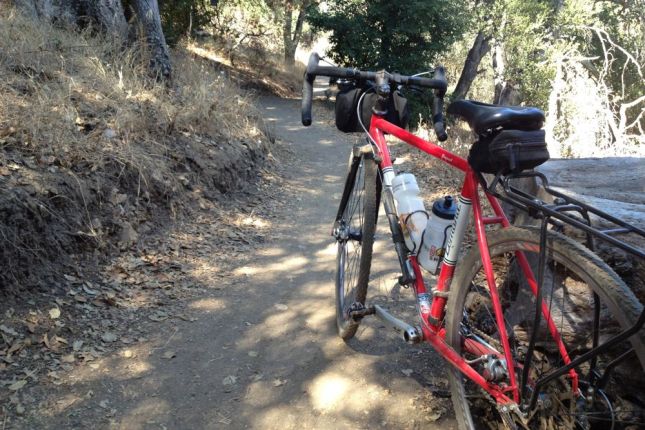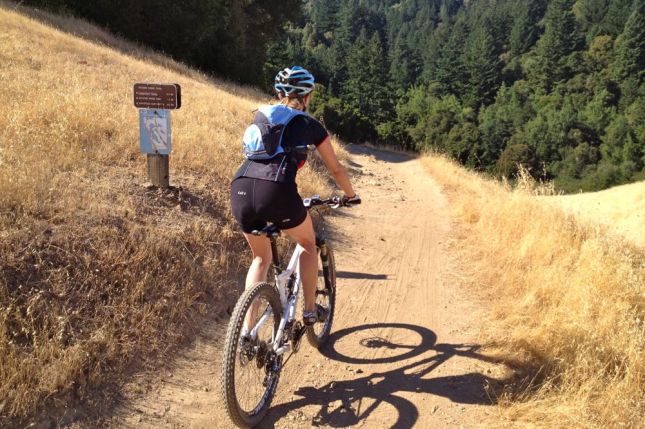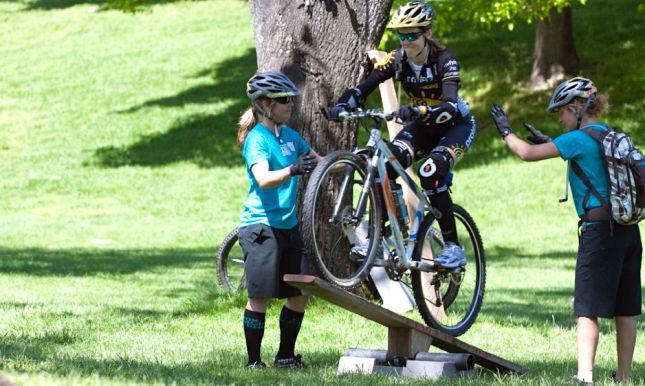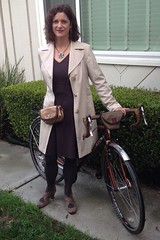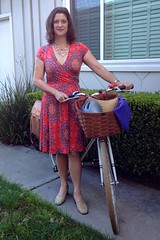Portions of this story first appeared online in Bike Fun in the Mountain View Voice on August 27, 2013.
When I bought my first adult bicycle back in 1994, I had a hard time deciding what to buy. A co-worker offered to sell me his old road bike, but I wanted to ride the gravel levee trails along the bay. I ended up going for comfort and bought an entry-level, fully rigid mountain bike that I rode around town and on the bay.
I had no intention of actually mountain biking until my friend Steph convinced me to ride some real dirt trails in the nearby hills. It was 10 miles of hard work and more climbing than I wanted, but I was hooked.
To me, mountain biking is a lot like hiking. You get out of the city and feel like you’re far away from it all, even when you’re only a few miles away. I’m always surprised how much wildlife there is so close to town, from deer to wild turkeys to coyotes to gopher snakes. If you’re lucky, you might spot a rattlesnake, bobcat or tarantula. I’ve seen all that and more, especially since I cover a lot more distance on a bike than on foot.
If you’ve only ridden on pavement before, there are some things you should know before hitting the dirt that will make your first ride a lot easier. Riding dirt isn’t hard if you make a few simple adjustments. And if you’re experienced at mountain biking and plan to take first timers out, reading the tips can help you remember all those skills you’ve learned that you now do by second nature.
First, on the trail there are a few new rules of the road. As a mountain biker you need to yield to hikers and horses, as well as uphill riders. In particular, be aware that you and your bike can make horses nervous because you look too much like predator. As you approach horses, slow down to crawl, call out “hello” as soon as you’re within voice range, and ask the horseback riders how to proceed. Sometimes they will want you to stop and let them pass, other times they’d rather pull off the trail and let you pass. It’s all about communication. The same advice works for hikers. Be polite, communicate with them and don’t buzz by.
As for your bike, any bike with knobby tires works and some people can rock the dirt on slick tires too. Having a fork with front suspension smooths out the trail, but isn’t necessary for the moderate trails I’ve listed below. To set up your bike before your first dirt ride, all you’ll probably need to do is pump up the tires and go. But not too much. Lower pressure in your tires gives better traction on loose dirt and gravel. I set mine at 35-40 psi, which is the far low end of what my tires recommend.
If your attitude about shifting gears is “set it and forget it” on the streets, you’ll need to review shifting. Most trails in our area have steep sections so you’ll want to use your gears. In particular, the wide gravel roads that may look easier than the narrow trails also tend to suddenly get steep. Unlike the narrow trails, they were built for farm trucks with engines, not people on foot or on bikes.
After that, it’s all about the ride. Here are some basic techniques that can help you feel more comfortable and stable riding dirt trails.
Ready position
The ready position is used when you’re rolling down a trail like my friend Cindy is in the photo below, or rolling over obstacles like ruts or roots. First, put your feet in the pedals level at 3 o’clock and 9 o’clock positions in a wide stance, then lift your rear out of the saddle, bend your elbows wide and look straight ahead down the trail. The goal is to stay balanced as the bike moves underneath you, like an English-style equestrian, where your legs are shock absorbers and you move forward and back and side to side as needed to stay balanced. Put one or two fingers lightly over each brake lever, place your palms lightly on grips and you’re ready to go.
Roots, rocks and ruts
You’ll need the ready position to roll over obstacles like ruts, roots and rocks. The other key is to brake as you approach the obstacle, then let go of the brakes and let your bike roll over the obstacle. For obstacles too big to roll over, look where you want to go to roll around it. Stare at that big rock and you’ll hit it for sure.
Climbing
Mountain biking gets its name because most trails are hilly, at least in our area. The good news is mountain bikes have lower gears than road bikes. Use them! Downshift to your small chainring (left hand shifter) before the hill and then use the gears in your cassette (right hand shifter) to find the right gear. On really steep hills, the tendency is either for your rear wheel to slide out or your front wheel to pop up. The trick to staying balanced is to stay in saddle, slide forward on the saddle and lower your chest toward the handlebars. And there’s no shame in walking up the hill if it’s too steep.
Descending
Descending starts with the ready position described above with your rear out of the saddle. As the trail gets steeper, move your body further back behind the saddle. Moving your body back means you can brake with both your front and rear brakes together without flying over the handlebars.
Tight turning
Tight turns in trails, also known as switchbacks, can be challenging and rewarding when you learn to ride them. The best line to take is to go wide before the turn, look down at the apex to turn sharply and as soon as your front wheel gets close to the apex, look far down the trail. And keep pedaling, especially as you exit the turn when the tendency is to coast. Don’t feel bad if you can’t make the turn. It takes practice and some are hard to clear for experienced riders.
Walking the bike
In mountain biking everyone walks the bike sometimes. The easiest was to push your bike is to stand on left side of it so you can avoid bumping the chainring. Put both hands on the handlebars. If you’re walking the bike downhill, feather the rear brake (right hand) to control your speed. On super steep uphills, you can brake hard and use bike as a cane to help balance as you walk up.
Finally, as trite as it sounds, relax. If the trail feels too intense or you find yourself tensing your body or squeezing the hand grips tight, slow down and or stop for a bit. A stiff body makes everything harder. Take a breath, enjoy the scenery, walk it off if you need to and then roll again.
For those living on or visiting the San Francisco Peninsula, here are two of my favorite local parks with trails that are great for first-time mountain bikers.
Arastradero Preserve in Palo Alto
Arastradero Preserve offers rolling grassy hills with wide gravel roads and narrower smooth dirt trails very close to town. The park is small, but with proper planning, you can ride a dozen or more miles without too much repeating, and you can reverse direction for a new experience. I’ve marked an easier first-timer’s loop on the map in pink, plus a bonus loop in purple. The blue loop is where my friends and I ride after work, which is a good time to visit since the park has very little shade. Here’s a map with my favorite easy loops marked.
Long Ridge Open Space Preserve on Skyline Boulevard
Long Ridge offers smooth and shady trails along Peter’s Creek and great views from the ridge along Skyline Boulevard. My favorite starting location is Grizzly Flat, which is 3.1 miles south of Page Mill Road or 3.3 miles north of Highway 9. Watch your odometer to find the trailhead at the unmarked roadside parking. Trail map.

